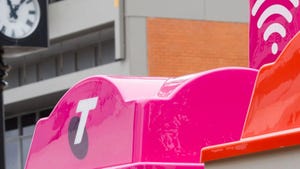Dish joins in with the 5G carrier aggregation brag-a-thonDish joins in with the 5G carrier aggregation brag-a-thon
US mobile newcomer Dish is keen to show it is just the same as its more seasoned competitors, by getting involved with some boasting about carrier aggregation (CA).
October 17, 2023

US mobile newcomer Dish is keen to show it is just the same as its more seasoned competitors, by getting involved with some boasting about carrier aggregation (CA).
Together with Samsung and Qualcomm, Dish said it has successfully – and simultaneously – combined two 5G uplink carriers and four downlink carriers using its FDD spectrum, claiming it is the first operator in the world to manage it.
In terms of speeds, it achieved 200 Mbps on the uplink using 35 MHz of spectrum, while download speed topped out at 1.3 Gbps using 75 MHz of spectrum. Dish said the demonstration was carried out using its 600-MHz, 1.7-GHz, and 2.1-GHz spectrum.
The demo took place in both Dish’s lab as well as in the field, using a test device powered by a Qualcomm Snapdragon X75 modem. Samsung supplied its 5G vRAN solution, and the whole thing ran on Dish’s dual and tri-band radios.
“The Dish 5G Open RAN network now covers over 73% of the US population with 5G broadband coverage, and more than 100 million Americans with 5G voice service – VoNR – with more markets going live each month,” said Eben Albertyn, EVP and CTO of Dish, in a statement. “By successfully delivering 5G 2x uplink and 4x downlink carrier aggregation for FDD spectrum, Dish is now poised to deliver a better customer experience across our 5G standalone network. We look forward to continuing to pave the way to fully harness the power of 5G.”
By bragging about 5G carrier aggregation, Dish has well and truly arrived in the US mobile market, if only because rivals T-Mobile, AT&T and Verizon, have all regularly made similar announcements over the years.
T-Mobile in July announced it has begun rolling out four-carrier aggregation on its 5G standalone (SA) network, claiming impressive peak throughput of 3.3 Gbps. In May, it partnered with Nokia and Qualcomm in a CA trial that reached 207 Mbps on the uplink.
AT&T in April announced that it had successfully aggregated two 5G uplink carriers, using different combinations of its 850-MHz, and 3.7-GHz spectrum. In one scenario, it combined its 850-MHz spectrum with as much as 100 MHz of 3.7-GHz to reach a speed of more than 120 Mbps. At the time it claimed it was the first 5G SA two-carrier aggregation data call in the US.
Meanwhile, Verizon in June last year took a slightly different approach, trying out carrier aggregation using shared CBRS spectrum. Together with partner Ericsson, it reached a peak download speed of more than 700 Mbps. It has also previously applied CA to its millimetre-wave (mmWave) frequencies, reaching a whopping 4.2 Gbps.
Making an announcement like this puts Dish in good company then, but there is one significant element that makes it different from CA announcements that have gone by – the fact that Dish is operating a cloud-native, Open RAN-based 5G network. Not even T-Mobile can say that, and T-Mobile has a lot to say about most things.
It’s also significant because Open RAN sceptics are keen to question whether Open RAN can match traditional RAN when it comes to performance. Granted, there is a lot more to operating a network than raw throughput, but announcements like this certainly won’t hurt the Open RAN cause.
Get the latest news straight to your inbox. Register for the Telecoms.com newsletter here.
About the Author
You May Also Like










.png?width=300&auto=webp&quality=80&disable=upscale)


_1.jpg?width=300&auto=webp&quality=80&disable=upscale)